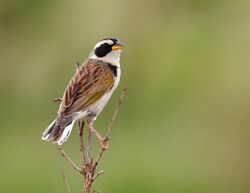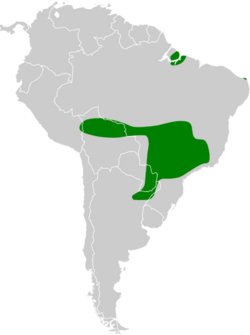Biology:Black-masked finch
| Black-masked finch | |
|---|---|

| |
| Black-masked finch at Serra da Canastra National Park, Minas Gerais State, Brazil | |
| Scientific classification | |
| Domain: | Eukaryota |
| Kingdom: | Animalia |
| Phylum: | Chordata |
| Class: | Aves |
| Order: | Passeriformes |
| Family: | Thraupidae |
| Genus: | Coryphaspiza G.R. Gray, 1840 |
| Species: | C. melanotis
|
| Binomial name | |
| Coryphaspiza melanotis (Temminck, 1822)
| |

| |
| Synonyms | |
|
Emberizoides melanotis (protonym) | |
The black-masked finch (Coryphaspiza melanotis) is a species of South American bird in the tanager family Thraupidae. It is the only member of the genus Coryphaspiza. It is found in Argentina, Bolivia, Brazil, Paraguay, and Peru. Its natural habitats are subtropical or tropical moist shrubland, subtropical or tropical dry lowland grassland, and subtropical or tropical seasonally wet or flooded lowland grassland. It is threatened by habitat loss.
Taxonomy
The black-masked finch was formally described in 1822 by the Dutch zoologist Coenraad Jacob Temminck under the binomial name Emberizoides melanotis.[2] This species is now placed in the genus Coryphaspiza that was introduced by George Robert Gray in 1840.[3][4] The type locality is São Paulo, Brazil.[5] The genus name combines the Ancient Greek koruphē meaning "crown of the head" with spiza meaning "finch". The specific epithet melanotis combines the Ancient Greek melas meaning "black" with -ōtis meaning "-eared".[6]
This species was traditionally placed with the buntings and New World sparrows in the subfamily Emberizinae within the family Emberizidae.[5] A molecular phylogenetic study published in 2014 found that the black-masked finch was embedded in the tanager family Thraupidae. Within Thraupidae the black-masked finch is now placed with Embernagra and Emberizoides in the subfamily Emberizoidinae.[4][7]
Two subspecies are recognised:[4]
- C. m. marajoara Sick, 1967 – Marajó Island (off northeast Brazil)
- C. m. melanotis (Temminck, 1822) – southeast Peru and east Bolivia to east, southeast Brazil, Paraguay and northeast Argentina
References
- ↑ BirdLife International (2018). "Coryphaspiza melanotis". IUCN Red List of Threatened Species 2018: e.T22723039A132020897. doi:10.2305/IUCN.UK.2018-2.RLTS.T22723039A132020897.en. https://www.iucnredlist.org/species/22723039/132020897. Retrieved 12 November 2021.
- ↑ Temminck, Coenraad Jacob (1838) (in fr). Nouveau recueil de planches coloriées d'oiseaux, pour servir de suite et de complément aux planches enluminées de Buffon. 3. Paris: F.G. Levrault. Plate 114, Fig. 1 (livraison 19). https://www.biodiversitylibrary.org/page/36704981. The 5 volumes were originally issued in 102 livraison (parts), 1820-1839. For the publication dates see: Dickinson, E.C. (2001). "Systematic notes on Asian birds. 9. The Nouveau recueil de planches coloriées of Temminck & Laugier (1820–1839)". Zoologische Verhandelingen, Leiden 335: 7–53. http://repository.naturalis.nl/document/46425.
- ↑ Gray, George Robert (1840). A List of the Genera of Birds : with an Indication of the Typical Species of Each Genus. London: R. and J.E. Taylor. p. 47. https://www.biodiversitylibrary.org/page/13668964.
- ↑ 4.0 4.1 4.2 Gill, Frank; Donsker, David; Rasmussen, Pamela, eds (July 2020). "Tanagers and allies". IOC World Bird List Version 10.2. International Ornithologists' Union. https://www.worldbirdnames.org/bow/tanagers/.
- ↑ 5.0 5.1 Paynter, Raymond A. Jr, ed (1970). Check-List of Birds of the World. 13. Cambridge, Massachusetts: Museum of Comparative Zoology. p. 209. https://www.biodiversitylibrary.org/page/14483444.
- ↑ Jobling, James A. (2010). The Helm Dictionary of Scientific Bird Names. London: Christopher Helm. pp. 119, 248. ISBN 978-1-4081-2501-4.
- ↑ Burns, K.J.; Shultz, A.J.; Title, P.O.; Mason, N.A.; Barker, F.K.; Klicka, J.; Lanyon, S.M.; Lovette, I.J. (2014). "Phylogenetics and diversification of tanagers (Passeriformes: Thraupidae), the largest radiation of Neotropical songbirds". Molecular Phylogenetics and Evolution 75: 41–77. doi:10.1016/j.ympev.2014.02.006. PMID 24583021. https://digitalcommons.lsu.edu/cgi/viewcontent.cgi?article=3613&context=biosci_pubs.
Wikidata ☰ Q1301134 entry
 |


